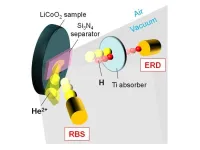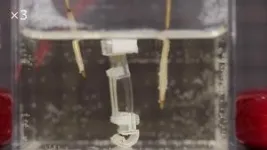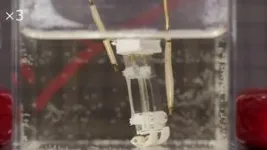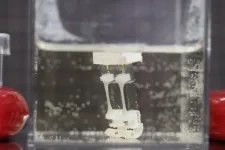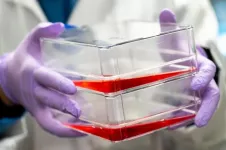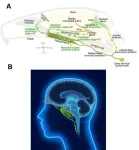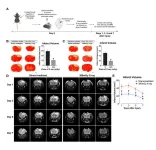Powering the future: Unlocking the role of hydrogen in lithium-ion batteries
Scientists investigate hydrogen uptake and loss from lithium-ion battery cathodes, paving the way for higher efficiencies and chemical energy storage
2024-01-26
(Press-News.org)
Lithium-ion batteries stand out as one of the most prevalent rechargeable battery technologies in the present era. Within these batteries, lithium-cobalt oxides (LiCoO2) are widely used as the materials for positive electrodes or cathodes (the conductors through which electric current either enters or exits a substance). The cathode plays a pivotal role in lithium-ion batteries and influences their capacity, performance over many charge-discharge cycles, and ability to manage heat.
One major issue leading to the deterioration of these batteries is the creation of hydrogen through the splitting of water. Therefore, gaining insights into how hydrogen builds up and is removed in LiCoO2 can greatly enhance the efficiency and functioning of solid-state lithium-ion batteries. Furthermore, this knowledge can lead to new ways to recycle used lithium-ion batteries to utilize them for hydrogen storage and production through the process of water splitting at room temperature.
Now, in a recent study published in the International Journal of Hydrogen Energy on 29 October 2023, led by Professor Bun Tsuchiya from the Department of General Education of the Faculty of Science and Technology at Meijo University, a team of researchers has conducted a thorough investigation into the hydrogen uptake and loss in LiCoO2 cathode materials immersed in water at room temperature. According to Prof. Tsuchiya, “My motivation is to achieve the production of hydrogen (H2) through water (H2O) splitting at room temperature using certain oxide ceramic materials. Usually, H is dissociated from H2O at around 2000 K. However, this is too much energy for effective H2 fuel production and for solving current environmental problems, such as long-term carbon dioxide emissions.”
The study aimed to explore how LiCoO2 materials store and release hydrogen and identify the most stable locations within the LiCoO2 structure for trapping hydrogen. This was done using various analytical techniques, including weight gain and elastic recoil detection methods. They revealed that the concentration of hydrogen increased after immersing the material in water for two minutes at specific temperatures. Additionally, gas chromatography was used to analyze the release of hydrogen gas and determine the temperature at which dissociation occurred, which was found to be below 523 K. The study also involved “density functional theory” calculations, which indicated that hydrogen atoms separated from water tended to prefer lithium sites over other locations in the crystal structure of LiCoO2.
Overall, the results suggest that LiCoO2 has a significant role in storing hydrogen at room temperature through the process of water splitting to produce hydrogen gas. “If it becomes possible to make H2 from the inexhaustible H2O on earth with low energy input, I think that we can potentially establish a hydrogen-based society in the future,” envisions Prof. Tsuchiya.
In summary, the researchers have investigated the storage and release of hydrogen in LiCoO2 cathode materials for lithium-ion batteries. By providing insights into a process that leads to degradation in this widely used technology, this study paves the way for the development of more efficient batteries as well as the low-energy production of hydrogen through water splitting, an environmentally friendly energy-storage technology!
END
ELSE PRESS RELEASES FROM THIS DATE:
2024-01-26
Compared to robots, human bodies are flexible, capable of fine movements, and can convert energy efficiently into movement. Drawing inspiration from human gait, researchers from Japan crafted a two-legged biohybrid robot by combining muscle tissues and artificial materials. Publishing on January 26 in the journal Matter, this method allows the robot to walk and pivot.
“Research on biohybrid robots, which are a fusion of biology and mechanics, is recently attracting attention as a new field of robotics featuring biological function,” says corresponding author Shoji Takeuchi of the University of Tokyo, Japan. “Using muscle ...
2024-01-26
Researchers in the RIKEN Center for Brain Science (CBS) examined the genetics of autism spectrum disorder (ASD) by analyzing mutations in the genomes of individuals and their families. They discovered that a special kind of genetic mutation works differently from typical mutations in how it contributes to the condition. In essence, because of the three-dimensional structure of the genome, mutations are able to affect neighboring genes that are linked to ASD, thus explaining why ASD can occur even without direct mutations to ASD-related genes. This study appeared in the scientific journal Cell Genomics on January 26.
ASD is a group of conditions characterized in part ...
2024-01-26
Cellular agriculture – the production of meat from cells grown in bioreactors rather than harvested from farm animals – is taking leaps in technology that are making it a more viable option for the food industry. One such leap has now been made at the Tufts University Center for Cellular Agriculture (TUCCA), led by David Kaplan, Stern Family Professor of Engineering, in which researchers have created bovine (beef) muscle cells that produce their own growth factors, a step that can significantly cut costs of production.
Growth factors, whether ...
2024-01-26
Tisch Cancer Institute researchers discovered that a certain type of chemotherapy improves the immune system’s ability to fight off bladder cancer, particularly when combined with immunotherapy, according to a study published in Cell Reports Medicine in January.
These findings may explain why the approach, cisplatin chemotherapy, can lead to cure in a small subset of patients with metastatic, or advanced, bladder cancer. Researchers also believe that their findings could explain why clinical trials combining another type of chemotherapy, carboplatin-based chemo, with immunotherapy have not been ...
2024-01-26
Following federal approval for over the counter emergency contraception in 2006, emergency departments across the U.S. saw dramatic decreases in related visits and medical charges, a new study suggests.
Emergency room visits related to emergency contraception fell by 96 %, from 17,019 to 659, while total related hospital expenses decreased by $7.2 million – from $7.6 million to $385,946 – between 2006 and 2020. The most notable decrease was between 2006-2007 for people primarily seen for emergency contraception.
The Michigan Medicine led findings appear in JAMA Network ...
2024-01-26
About The Study: The results of this study of approximately 18 million health care industry employees suggest a substantial and persistent increase in health care workforce turnover after the pandemic, which may have long-lasting implications for workers’ willingness to remain in health care jobs. Policymakers and health care organizations may need to act to prevent further losses of experienced staff.
Authors: Karen Shen, Ph.D., of the Johns Hopkins Bloomberg School of Public Health in Baltimore, is the corresponding ...
2024-01-26
About The Study: In this study of 824 N95s used by 412 emergency department health care workers practicing N95 reuse, fit failure occurred in 38.7% of masks after one shift. Trifold N95s had higher incidence of fit failure compared with dome N95s. These results may inform pandemic preparedness, specifically policies related to N95 selection and reuse practices.
Authors: Ralph C. Wang, M.D., M.A.S., of the University of California, San Francisco, is the corresponding author.
To access the embargoed study: Visit our For The Media website at this link https://media.jamanetwork.com/
(doi:10.1001/jamanetworkopen.2023.53631)
Editor’s ...
2024-01-26
About The Study: In this study of patients enrolled in Medicare in 2022, those at the highest risk for severe COVID-19 infection received COVID-19 therapy less often than those with the least risk. Disparities in therapy access were found by patient age, race and ethnicity, Medicaid eligibility, and nursing home residence.
Authors: Michael L. Barnett, M.D., of the Harvard T.H. Chan School of Public Health in Boston, is the corresponding author.
To access the embargoed study: Visit our For The Media website at this link https://media.jamanetwork.com/
(doi:10.1001/jamahealthforum.2023.5044)
Editor’s ...
2024-01-26
In a groundbreaking study published in Nature, South Korean researchers led by Director KOH Gou Young of the Center for Vascular Research within the Institute for Basic Science (IBS) have uncovered a distinctive network of lymphatic vessels at the back of the nose that plays a critical role in draining cerebrospinal fluid (CSF) from the brain. The study, sheds light on a previously unknown route for CSF outflow, potentially unlocking new avenues for understanding and treating neurodegenerative conditions.
In our brains, ...
2024-01-26
Traumatic brain injury (TBI) and ischemic stroke are major public health concerns and leading causes of death and disability worldwide. A research team led by City University of Hong Kong (CityU) neuroscientists recently discovered that low-dose ionizing radiation (LDIR), such as X-ray irradiation, can reduce lesion size and reverse motor deficits in TBI and ischemic stroke mice, demonstrating that LDIR may be a promising therapeutic strategy for TBI and stroke patients.
Nearly half of TBI and stroke survivors experience lifelong motor impairment and disability. “Usually, secondary brain damage worsens over time after primary ...
LAST 30 PRESS RELEASES:
[Press-News.org] Powering the future: Unlocking the role of hydrogen in lithium-ion batteries
Scientists investigate hydrogen uptake and loss from lithium-ion battery cathodes, paving the way for higher efficiencies and chemical energy storage
